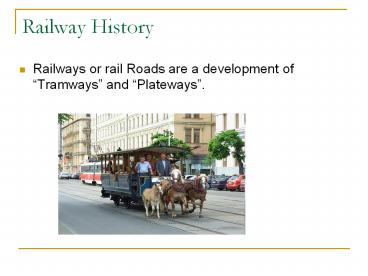Railway History - PowerPoint PPT Presentation
Title:
Railway History
Description:
Railway History Railways or rail Roads are a development of Tramways and Plateways . Age of Steam Diesel Engines Electric Power Railways Railway or ... – PowerPoint PPT presentation
Number of Views:7177
Avg rating:3.0/5.0
Title: Railway History
1
Railway History
- Railways or rail Roads are a development of
Tramways and Plateways.
2
- Age of Steam
- Diesel Engines
- Electric Power
3
Railways
- Railway or Permanent-way is the combination of
rails, sleepers, fittings, ballast etc.
4
Rail Gauges
5
Definition
- Rail gauge is the distance between the inner
sides of the two parallel rails that make up a
single railway line.
6
Dominant gauges
ft' in" mm
5' 6" 1676
5' 5.85" 1668
5' 3" 1600
5' 1524
4' 11.85" 1520
4' 8.5" 1435
4' 6" 1372
3' 6" 1067
3' 5.35" 1050
3' 3.37" 1000
3' 4.1" 950
3' 914
2' 6" 762
2' 5.55" 750
2' 610
1' 11.6" 600
7
Dominant gauges
1,676 mm (5 ft 6 in) Indian gauge India, Pakistan, Argentina, Chile
1,668 mm (5 ft 5? in) Iberian gauge Portugal, Spain
1,600 mm (5 ft 3 in) Irish gauge Ireland and important minor gauge in Australia
1,524 mm (5 ft) Russian gauge Finland, Estonia
1,520 mm (4 ft 11? in) Russian gauge CIS states, Latvia, Lithuania, Mongolia
1,435 mm (4 ft 8½ in) Standard gauge Europe, North America, China, Korea, Australia, Middle East, North Africa, Mexico, Cuba, Panama, Venezuela, Peru, Uruguay (60 of the world's railways) Also high-speed lines in Japan and Spain.
1,067 mm (3 ft 6 in) Cape gauge Southern and Central Africa, Indonesia, Japan, Taiwan, Philippines, New Zealand, Australia
1,000 mm (3 ft 3? in) Meter gauge India, Brazil, Bolivia, northern Chile, Kenya, Uganda
Gauge
Name
Usage
8
INDO-PAK policy for Gauge
- The total cost of construction railway directly
depends on gauges, wider the gauge higher will be
the cost. - At the time of construction of railway the policy
was adopted that the gauge will depend on the
intensity of traffic.
9
INDO-PAK policy for Gauge
- Commonly used gauges in INDO-PAK are
- Broad Gauge
- Meter Gauge
- Narrow Gauge
10
Broad Gauge
- Broad gauge refers to any gauge wider than
standard gauge or 1,435 mm (4 ft 8½ in) - Broad gauge is used to provide better stability
and provide the easy transfer of rolling stock. - It is used for main cities and routes of heavy
intensities
11
Meter Gauge
- Standard gauge is referred the gauge having a
length equal to 1.00-m - It is used in undeveloped area having
comparatively Less intensity.
12
Narrow Gauge
- In hilly areas and very thinly populated areas
where it uneconomical to use Meter gauge, narrow
gauge is used. - 2-00 and 2-6 Narrow gauges are generally used.
13
Common gauges in INDO-PAK
14
Difficulties Due to Change in Gauge
- At every change of gauge the passenger have to
change the train which cause much inconvenience
to the passengers. - At the junction the goods are to be unloaded from
the train and loaded into another which requires
extra labor and goods likely to be damaged. - The owner will have to pay extra charges for the
labors causing increase in the price. - Surplus wagons and engine of the one gauge can
not be utilize on the other.
15
Continued.
- During war times change in gauge causes extremes
difficulties to the army and checks their quick
movement. - If the intensity of the traffic become more and
requires wider gauge it will be impossible to
change it because the change in gauge mean
changing of each and everything i.e. rails,
locomotives, bridges, tunnels etc.































